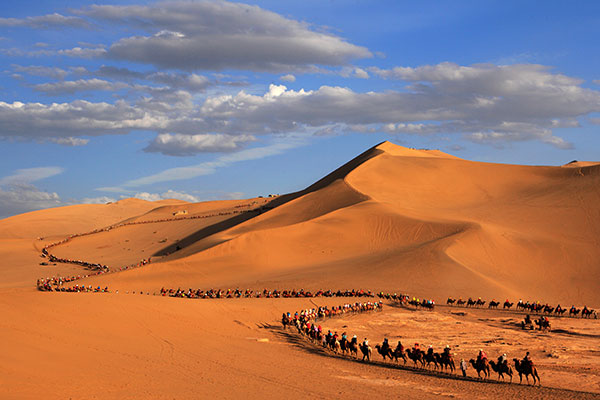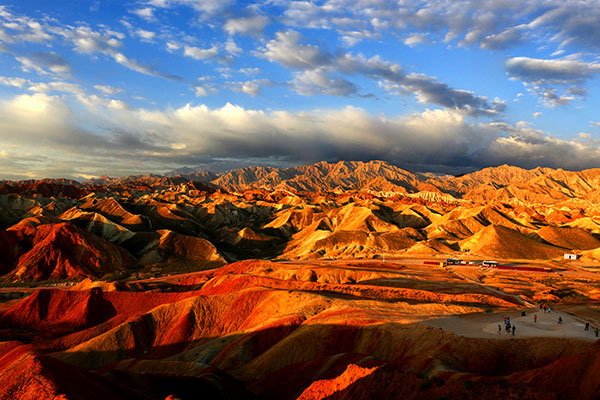
Camel caravans in the heart of a desert in Gansu province. The Discovering the Beauty of Silk Road project invites photographers to explore the landscape of western China.[Photo by Hu You/ China Daily]
After focusing their lenses on the beauties of two ancient capitals of Xi’an and Luoyang on the Silk Road last year, photographers are now being invited to discover the beauty of western China’s Gansu province, where goods were transported on camelback through its magnificent deserts hundreds of years ago.
The Discovering the Beauty of Silk Road project, initiated by Canon, was launched in 2014 and documented culture, landscapes, architecture and traditional craftsmen in cities in Shaanxi and Henan provinces, the starting locations of the Silk Road. This year, photographers will go deep into six cities in Gansu province from June to October, including Dunhuang, famous for its grottoes and Buddhist murals.
All photos selected will be donated to the Protection Center of China’s Intangible Cultural Heritage.

The Discovering the Beauty of Silk Road project invites photographers to explore the landscape of western China.[Photo by Hu You/ China Daily]
The six cities to be photographed are along the well-known Hexi Corridor, including Wuwei, Zhangye, and Jiayuguan, historical sites that have witnessed wars and produced legendary heroes and celebrated poets. More importantly, they were vital centers of culture, religion and arts that were spread between East and West.
Ye Zhou, writer and winner of the Lu Xun literary award, says that different parts of China have started to look at the country’s western areas to seek a revival of the spirit, similar to American’s Westward movement 200 years ago.

The Discovering the Beauty of Silk Road project invites photographers to explore the landscape of western China.[Photo by Hu You/ China Daily]
“Western China was once prosperous in the Han Dynasty (202 BC-220). Now when we look back to the land of deserts and dunes, we are seeking a kind of spirit that we’ve lost,” says Ye, who has taken on the role of scholar on the photography project.
Ye says people living on the yellow landscape are fond of eating chunks of meat and drinking in bowls, nurtured by the “big” vistas and culture. He suggests that photographers should take buses or trains instead of planes to have a better view of the magnificent land consisting of deserts, the Yellow River and glorious grottoes.
Lu Jie, communications director for Canon China, says that culture and traditional craftsmen are the main focus of the project.
Last year, a team of photographers shot shadow plays and Qinqiang, also known as Shaanxi Opera, popular in China’s northwestern provinces. They went to visit experienced opera singers in villages and invited a local Shaanxi opera team to perform outside the Daming Palace in Xi’an.
One member of the opera team, 78-year-old Wang Zhengzhong, was in the hospital when the photographers went there. But he insisted on performing for them because he was worried he had few chances left to do so.
“We have to be quick on documenting intangible heritage. Traditional craftsmen and folk arts are on the verge of extinction at a fast speed,” says Lu.
The photographers included professionals and amateurs interested in the culture of the Silk Road. Last year, an American who learned Chinese in Beijing applied for the project and got the chance to capture traditional craftsmen little-known by the public. There was also a young Chinese in his early 20s, who took gorgeous photos and won photography competitions later.
“It’s interesting to see how people from the West present Chinese culture and also to see how members of the young generation think about their traditions,” adds Lu.
Lu says the project welcomes a diversity of people to take part in the project to show the beauties on Silk Road from their own perspectives. After the photo shooting, there will be forums to discuss the culture and exhibitions to display these images to the public.
The project will go to Ningxia Hui and Xinjiang Uygur autonomous regions next year.
